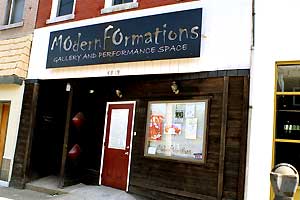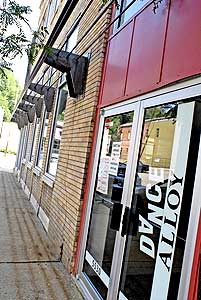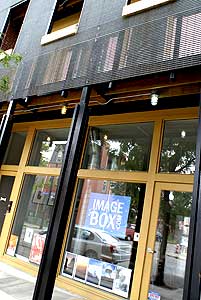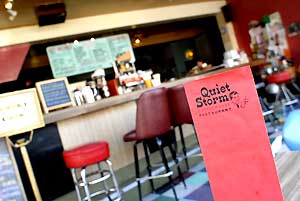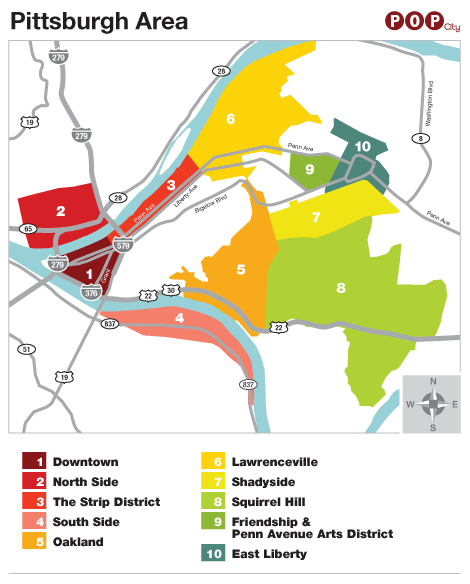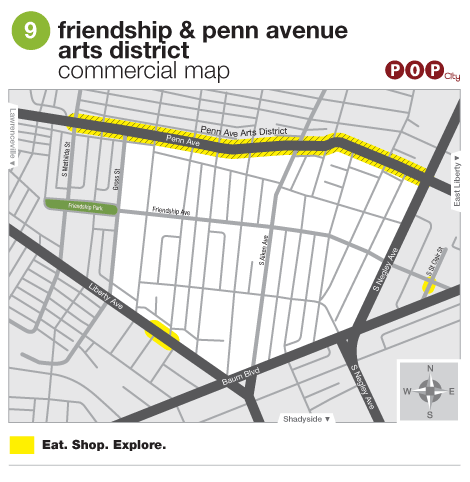
Category Archive: News Wire Services
-
Blast From the Past: Old Steel Mill Forges New Life as a Park
Ben Muessig
AOL News(Dec. 2) — Preservationists outside Pittsburgh are fighting to put an abandoned steel mill back to work — not so it can produce metal, but so it can protect history.
Since the blast furnaces fired up for the last time at the Carrie Furnace in 1978, the decaying steel mill on the bank of the Monongahela River has served as a solemn reminder of the industry that turned Pittsburgh into a thriving city — then left it polluted and jobless.
Now, more than three decades after the Carrie Furnace went from being a bustling workplace for 4,000 employees to a 168-acre ghost town, a team of preservationists is trying to convert the remains of the hulking factory in Rankin, Pa., into a museum dedicated to the region’s steel history.
“Pittsburgh is known for steel,” said Sherris Moreira, a spokeswoman for Rivers of Steel Heritage Corp., the group spearheading the preservation project. “There is this pride that people here have for their steel heritage — and this is a tangible way for people to connect with that history.”
Rivers of Steel hopes to preserve the remaining structures, transforming the industrial ruin into an interactive historical center inside a park.
At the heart of the proposed preservation project are the two remaining blast furnaces, which were built in 1907 and left largely unchanged until U.S. Steel halted operations at the Carrie Furnace.
The massive ovens are rare examples of pre-World War II steel-making technology — and they could make the perfect centerpiece for the proposed museum, according to Rivers of Steel curator of collections Tiffani Emig.
“They were never invested in for improvements and they were never upgraded. Everything was done by hand up until the day it closed,” Emig said. “That’s what makes them special.”
Those industrial relics — along with five other furnaces that were demolished — manufactured as much as 1,200 tons of iron per day, creating metals used in the construction of the Empire State Building and St. Louis’ Gateway Arch.
When the blast furnaces were operational, they turned ore, coke and limestone flux into a molten metal that was transported by rail across the aptly named “Hot Metal Bridge” to U.S. Steel’s Homestead Works, where it was converted into steel.
The Homestead Works were razed in 1988 and the site was converted into a shopping mall in 1999. Today, all that remains of the historic steel mill are the smokestacks, which tower over a movie theater parking lot across the river from the Carrie Furnace.
The Carrie Furnace has already been deemed a National Historic Landmark, meaning it likely won’t meet the same fate as the Homestead Works. But that doesn’t mean the site isn’t in danger.
When industry moved out, nature moved in. Tree roots have undermined the stability of some Carrie Furnace buildings, and grapevines scale the superstructure of the sprawling mill. Foxes, hawks and deer have recently been spotted on the site — and they’re not the only new visitors.
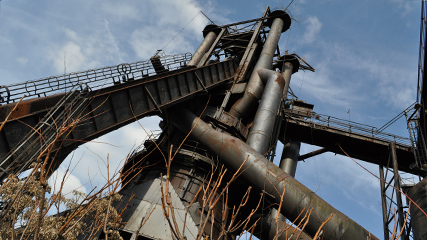
Since U.S. Steel halted operations at the Carrie Furnace in 1978, nature moved in. Trees tangle their way through the plant, and grapevines crisscross the catwalks. Ben Muessig for AOL News
The abandoned steel mill has become a destination for graffiti artists, paintball players, vagrants and vandals who strip the site and sell the stolen scrap metal.
“The wiring and anything else that can be scrapped has been taken out,” said Emig, who told AOL News she’s often chased away uninvited visitors. “With the graffiti, the paint wears off. It’s the people who are physically stripping the site who are the problem.”
Rivers of Steel plans to restore some parts of the Carrie Furnace to look the way they did when the plant was operational. But other parts — like a massive sculpture of a deer head built from metal and wire in the 1990s by the Industrial Arts Co-Op — will remain as they are today.
“We will preserve some of the graffiti, definitely the deer,” Emig said. “This site didn’t die in 1978. This place continued to be used, and we want to show that.”
Even if Rivers of Steel gets its wish and is able to preserve the remaining steel mill structures, the rest of the 168-acre property could look very different in the coming years. Allegheny County owns the entire site and began renting the Carrie Furnace buildings to Rivers of Steel in May.
County officials are looking for builders interested in bringing light manufacturing and residential development to the rest of the grassy plot.
New businesses or homes near the old steel mill will certainly change the site’s context, but they won’t compromise the Carrie Furnace as a historic site, according to Emig.
“It’s already compromised,” she said. “There’s only two furnaces left; there used to be seven. You work with what you have.”
The most important thing the Carrie Furnace has is its historic site, according to Arthur Ziegler, president of the Pittsburgh History and Landmarks Foundation.
“We have saved artifacts from the mills — blowing engines, a Bessemer converter and so forth — but we had to relocate them,” Ziegler said. “But this will be the first time it’s all preserved on site.”
Obviously, making the dilapidated steel mill a safe destination for sightseers isn’t going to be easy — or cheap.
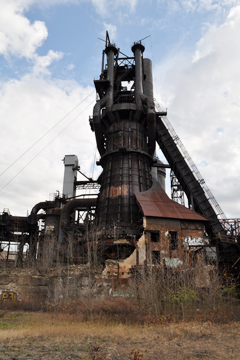
Turning the decaying steel mill into a park and history center won't be cheap -- but preservationists say residents of the "Steel City" are rallying behind their plan. Ben Muessig for AOL News
The group’s “bare-bones cost estimate” for the project is $78 million. Current funding only allows for repairs of a severely damaged roof at one of the powerhouses.
To fund other projects, like securing shaky catwalks, clearing out tons of debris from the mill’s stock house, or perhaps building a monorail like the one depicted in flashy conceptual images of the historic center, the group will seek public funding and private donations.
There’s talk of approaching the National Parks Service for help, but it’s unclear whether the cash-strapped agency would be interested in or able to offer assistance.
Though finances are a concern, Moreira says she’s been encouraged by the interest in the project.
“Heritage matters,” said Moreira, whose group has given tours of the Carrie Furnace to more than 700 eager visitors in the past two months. “It’s not only important to know where we come from, but it’s important looking to the future.”
In the years since the steel industry left Pittsburgh, the “Steel City” has in many ways attempted to distance itself from its metal-producing past. But the city’s industrial legacy lives on — and not just in the name of its football team and local beer.
According to Moreira, many Pittsburghers have started looking to the city’s steel-making roots as a source of pride.
“There was a lot of bitterness when the steel went away. People wanted to move on. But now people are at the point where they want to look back,” she said.
“This isn’t just steel; it’s about emotions.”
-
Washington County Farm on Statewide Danger List
Monday, December 20, 2010By Len Barcousky, Pittsburgh Post-GazetteA Washington County farm that has been operated by the same family for more than 200 years has been included on a list of 10 historic sites most at risk across Pennsylvania.
Longwall coal mining could harm several historic buildings at Plantation Plenty in Independence Township, according to Preservation Pennsylvania. The nonprofit organization released its list of endangered properties on Thursday.
State and federal environmental and preservation regulations require an analysis of the impact of commercial activities like mining on historic properties, according to Erin Hammerstedt, a field representative for Preservation Pennsylvania and the National Trust for Historic Preservation.
“Our goal would be to keep longwall mining out of this historic farm,” she said.
Preservation Pennsylvania is a private membership organization that seeks to protect historically and architecturally significant properties. The National Trust for Historic Preservation, created by Congress in 1949, plays a similar role across the country.
Plantation Plenty has been operated since 1800 by Isaac Manchester and his descendants. Joseph Pagliarulo and his wife, Margie, who is a Manchester descendant, acquired the 400 acres in 2005 and now run it as an organic farm, producing milk, beef, pork and vegetables.
The Manchester family had sold coal rights to the property in 1915, except for three acres under the farmhouse and other nearby buildings. The mining rights are owned by Penn Ridge Coal, a subsidiary of Alliance Resource Partners, a Tulsa, Okla.-based coal producer with $1.2 billion in revenues.
While longwall mining would never occur directly under the farmstead, major mine subsidence nearby still could damage the structures, Ms. Hammerstedt said. Another possible side-effect of the mining could be to degrade or ruin the farm’s water supply by fracturing the rock that feeds its springs and wells, according to Preservation Pennsylvania.
Penn Ridge has not yet applied for mining permits, Mr. Pagliarulo said, but he fears “it is just a matter of time.” He said it is not financially possible for him and his wife to buy back the coal rights.
An end to farming on the Manchester property would represent a cultural and environmental loss, he said.
“This property has been in my wife’s family for more than 200 years,” he said. “A visit here lets you step back in time … and see how 18th and 19th century farming took place.”
Two other Western Pennsylvania properties or areas are on the preservation organization’s list.
Holland Hall in Meadville, which has been vacant for 15 years, is in danger of demolition, according to Preservation Pennsylvania. The poor condition of the building — many interior walls and electrical, plumbing and heating mixtures have been removed — make it attractive to a buyer who would tear it down and replace it with a new structure.
Holland Hall was built in 1899 by A.C. Huidekoper, a Civil War veteran who made fortunes in coal, iron, oil and railroad businesses. The Gilded Age mansion was built around a smaller red-brick building constructed in 1804. Mr. Huidekoper and his wife, Frances, had lived in the smaller structure before the larger house was built.
Following the death of Mrs. Huidekoper, Holland Hall was sold and used as a fraternity house from 1935 to 1995. Plans to redevelop it as a conference center and bed-and-breakfast fell through.
“In order to prevent the demolition or continued neglect of Holland Hall, a buyer interested in acquiring and rehabilitating this architecturally significant building is needed,” according to “Pennsylvania at Risk 2010,” the organization’s newsletter.
Plans for a wind farm on the crest of Evitts Mountain in Bedford County’s Bedford Township could endanger a rural historic district known as Dutch Corner, according to Preservation Pennsylvania.
Dutch Corner has more than 30 farmsteads and a historic school, church and several cemeteries.
Plans to build 24 wind turbines on the ridge above the valley would require blasting and filling to construct concrete foundation pads and to bury a transmission cable, according to the organization. It also warns that noise from the wind turbines would disturb the neighborhood’s rural character while the blasting could affect water supplies.
Preservation Pennsylvania does not oppose either longwall mining or wind farms in general, Ms. Hammerstedt said. “There are places where these activities are a good thing,” she said. “But there are other areas where these projects are not appropriate, because they would endanger historic buildings or landscape features.”
Preservation Pennsylvania’s 2010 list of at-risk sites is available on its Web site, www.preservationpa.org.
-
The Visitor’s Guide to Friendship
Pop City MediaKelli McElhinny | Wednesday, September 13, 2006If you haven’t been to Friendship’s northern border of Penn Avenue lately, you’re in for a sweet surprise. The transformation, from a blighted area to a vibrant arts district, is well underway, courtesy of the Penn Avenue Arts Initiative (PAAI), a strategic partnership between the Friendship Development Associates and Bloomfield-Garfield Corporation. Today, many of Pittsburgh’s best-kept secrets, from art to architecture, can be found in Friendship.
The gutsy transformation has been driven by the PAAI, a formidable group which helps artists buy and renovate properties, provides technical assistance to artists, and promotes them as well as the neighborhood. The group even connects artists to local youth and their families through fun events and workshops that benefit all involved.
The liveliest time to visit this vibrant neighborhood is the first Friday of each month, for the PAAI showcase, Unblurred, when the area’s galleries and businesses throw open their doors to host a variety of events, from openings to art workshops. Despite gloomy weather and the threat of rain at the September event, music filled the air and hundreds of people jammed the galleries in the festive gathering on Penn Ave.
Mural Mural on the Wall
As you work your way down the street (Penn Ave, that is) keep on eye on the building walls of Friendship where some of the neighborhood’s most intriguing public art –such as the well-known The Bride Mural—can be found.
The landmark Bridal Mural, designed and created by the late Judy Penzer and Jill Watson, fools the eye by depicting a continuation of the row of buildings next to it. In 2001, “The Gateway,” mural was created by local artists at 5149 and 5150 Penn Avenue to represent the mission of PAAI – bringing the arts on both sides of Penn Avenue together via the street itself. Another notable mural is at 4908 Penn Avenue. Titled “Today’s Heroic Paragon,” it was created by Kevin Fung in 2003 in memory of a resident.
Many of the murals are the product of the Sprout Fund, a much-admired foundation located in Friendship that funds arts and other area projects that enliven the city as well as stimulate economic development by making the region attractive to young people.
The Art of Dance. And Foursquare.
The eastern end of Penn Avenue in Friendship is home to Attack Theater, one of Pittsburgh’s most innovative performing arts groups. In studio space at the corner of Penn and Mathilda, the dance troupe holds occasional informal performances in addition to offering modern dance classes to the community on Tuesdays. Unblurred attendees wanting to nurture their inner child can stop by for Game Night, to play foursquare, 3D tic-tac-toe, and Connect Four, and enjoy intermittent performances.
Further along Penn Avenue, you’ll find a group of modest galleries where hipsters – with a few adventurous suburbanites mixed in – spill out onto the sidewalk. Visitors to Modern Formations can settle into one of the comfy couches to enjoy a performance by local musicians, or peruse the pieces by Pittsburgh artists that grace the gallery’s purple walls.
Next up is Garfield Artworks, which shows local, regional and national artists, features a 100-foot-deep floor plan that lends itself to a multitude of uses, from performances to poetry readings to private parties.
At this point in the trip down Penn, a quick detour down Winebiddle Street is worthwhile to see the Waldorf School of Pittsburgh, located in one of the neighborhood’s oldest and most beautiful buildings. Originally a private residence that was converted into a convent for sisters of the Ursuline order, the building now houses the private K-8 school that moved to Friendship from the South Side in 2003. This historic landmark still hosts private events, in addition to its everyday function.
Back on Penn Avenue, head for the Clay Penn, with its storefront graced with thousands of mosaic tiles, many designed by Unblurred participants in a workshop. Owner and artist Laura Jean McLaughlin showcases her own work in the first-floor space, along with exhibitions by other artists. Soon, community classes and workshops will be offered here, too.
Next stop? Studio 5013 where, at any time, you can view a window display of one of many local artists since it’s illuminated for nighttime browsing. Behind the gallery curtain, artist Laura Shaffalo has done a tremendous job restoring the building’s splendor in creating her own live/work space, refinishing the building’s original pine floors and preserving architectural features such as the French doors.
There’s still room for improvement but The Penn Avenue Arts District continues to blossom and grow with each passing month. Since July, Penn Avenue has seen the opening of four additional galleries: IMAGEBOX at 4933 Penn Avenue, < c > space at 4823 Penn, ON Gallery at 5005 Penn and 5151 Penn Gallery.
At < c > space, a live band entertained a throng of visitors during its opening event September 1st. Guests were treated to art and music on the first floor, along with an appetizing spread of food and drinks, while upstairs the hip, renovated living quarters were open for viewing.
On September 14th, ON Gallery plays host to noted author, Mary Gaitskill, in a Pittsburgh Arts & Lectures event.
Wine and dine
Hungry? You’re in a great spot for some of the city’s best offerings in ethnic fare. Although the selection is small, the cuisine is top-notch. The locals swear by the curry at People’s Indian Restaurant, and Pho Minh is one of Pittsburgh’s few spots for authentic Vietnamese. Those with less exotic tastes can grab a slice with just the right amount of grease without parting with too much dough at Vince’s Pizza or Calabria’s.
A little farther up the street, past two institutions found in nearly every urban neighborhood – the dollar store and the funeral home – lies one of Penn Avenue’s most eclectic spots, the Quiet Storm. Complete with a vegan-friendly menu, an abundance of toys for folks under 10 (and ample space in which to play with them), and a magazine selection that puts the corner newsstand to shame, this nuisance bar-turned-coffeehouse draws in a mélange of characters from all over the city, whether a family stopping in for Sunday brunch or a doctoral student hunkering down to work on his thesis. The menu alone makes the Quiet Storm a must to visit, but those who need extra motivation might find it in the live performances hosted by the coffeehouse on Friday and Saturday nights.
Another option within walking distance is Silky’s Pub, a cozy Liberty Avenue bar that gives patrons the opportunity to brush up on their shuffleboard skills while sipping a beverage. At the end of Friendship Avenue, the popular Sharp Edge features such an extensive collection of Belgian beers that the owner has been knighted in Belgium.
Across the street from the Quiet Storm is the highly regarded EDGE studio, a cutting-edge architecture firm that regularly brings artists of international stature regularly into their gallery.
Reaching the eastern end of Penn Avenue, you’ll find one of the nation’s best glass facilities, and possibly in a class by itself, the Pittsburgh Glass Center. Housing large studios in space that formerly served as a car showroom, PGC is known across the country for the quality of art it produces–American Style magazine recently noted that it put Pittsburgh on the map for glass– and the community is encouraged to participate in the process. The facilities are impressive: eight glory-holes, a flame-working and a cold-working studio, natural gas and propane hand-torches and a roomy gallery to display the stunning glass work creations. A variety of classes you won’t find elsewhere are offered by masters in their art form, from glassblowing to bead making, and participants of all skill levels can find a course that fits their experience.
More classes of a different variety can be found just down the street from the PGC. The Neighborhood Dance Center, home to Dance Alloy Theater, provides space for one of the region’s most comprehensive community dance and fitness programs as well as their own professional modern dance company. Courses grouped by age allow a range of participants from toddlers to grandmas to enjoy activities from ballet to tango to Pilates. There’s no better place in Pittsburgh to get moving – and meet new friends. The company performs on a biannual home season with smaller showings throughout the year.
How to get there
What’s the best way is to get to this evolving neighborhood? Public transportation choices are plentiful. Eight PAT routes travel through one of Friendship’s main thoroughfares. If you choose to come by car, street parking is almost always available as well, if not on Penn, then no more than two blocks away on one of the cross streets.
Here are the main PAT routes to get you around the neighborhood.
Baum Boulevard: 77A, 77B
Centre Avenue to Downtown: 71A via Oakland, 81B via the Hill District and 86A via Bloomfield and the Strip District
Friendship Avenue to Downtown and East End destinations (such as Highland Park, the Pittsburgh Zoo and Morningside): 77D, 77F and 77GPenn Avenue: 86B to the Strip District and Downtown, 89A to the East Liberty shopping district and Martin Luther King, Jr. East Busway
Routes 77A, 77B, 81B, 86A and 86B also serve East Liberty shopping areas.While the first Friday of the month is when Friendship is showcased at its finest, anytime is a good time to visit this up and coming neighborhood.
-
Buncher Co. to Redevelop Terminal Produce Building and Build on Unused Riverfront Land
Pop City Media
Wednesday, December 15, 2010
The Urban Redevelopment Authority has agreed to lease–with an option to sell–the 130,000-square-foot Fruit Auction Terminal Produce Building on Smallman Street in the Strip District. The Buncher Co. plans to turn the building into a thriving commercial space.
To purchase the building, Buncher must commit to building 75-units of residential housing on the 55-acres of surface parking behind the Terminal Building. The firm must also promise to preserve the historic architecture.
“The building really is at the end of its useful life. It needs anywhere from $6 to $10 million in capital improvements to bring it up to code and preserve it,” says Rob Stephany, executive director of the URA.
According to Stephany, Buncher is about 20% of the way into their planning process, having selected the renowned historic preservation architect Albert Feloni to create a master plan for the Terminal Building. Astorino is under contract to do the master plan for the vacant surface parking along the river between the convention center and 41st Street.
Once Buncher submits the master plans to the URA for review, the gears of construction can really start turning. Stephany says a recently conducted market analysis indicates the building would best benefit from restaurants, office, and showroom spaces on the platform, citing the Society for Contemporary Craft and The Pittsburgh Public Market as examples of forward-thinking reuse of these kinds of buildings.
As part of the project, the URA and the City recently rezoned part of the Strip as a redevelopment area, causing concern from some neighborhood stakeholders who thought the URA might be preparing for eminent domain seizures. Stephany says that while this is certainly not the case, they didn’t do a good of a job in communicating their plans. Their intent was to make funds from investors more flexible.
Sign up to receive Pop City each week.
Writer: John Farley
Source: Rob Stephany, URA
Photograph copyright Brian Cohen -
Buncher Plans Project for Strip District’s Fruit Auction Terminal Building
Pittsburgh Business Times – by Tim Schooley
Date: Thursday, December 9, 2010, 10:27am EST
In a bid to spark a transformational wave of development in the Strip District, Pittsburgh’s Urban Redevelopment Authority will vote on a plan to beat a path to the Allegheny riverfront this week through the red brick walls of the Pennsylvania Railroad Fruit Auction Terminal Building.
At its board meeting scheduled for Thursday, Dec. 9, the URA is expected to vote for the city to enter into an agreement in which it would lease the six-block-long building to the Buncher Co., giving the local development company an option to buy the property. A vote of approval by the mayor-appointed board is expected to provide Buncher with the opportunity to develop the building in tandem with a 75-unit apartment project on riverfront land Buncher owns behind the building, according to URA Executive Director Rob Stephany.
Stephany described the plan as a key move to kick-start development of approximately 55 acres Buncher owns that extend along Smallman Street and the Allegheny River from 11th to 23rd streets, a tract of largely undeveloped urban land he believed is as large as any of its kind in the country.
“The produce terminal is kind of at the end of its useful life. It needs to be part of something bigger,” Stephany said. “My gut tells me there’s a real strong appetite by the Buncher Co. to really begin this project in earnest.”
Calls to Buncher were not immediately returned.
Stephany said Buncher has demonstrated its commitment to push forward with development there by hiring MacLachlan, Cornelius & Filoni Inc. to handle the preservation and design for the renovation of the 130,000-square-foot terminal building, a project he estimated will cost from $7 million to $10 million. The redevelopment of the terminal building, now home to number of produce wholesalers as well as the Pittsburgh Public Market, which opened a few months ago, will serve as a gateway project that should allow Buncher to being to develop the 12 to 15 acres behind it that have been largely blocked from any new plans by the building.
The redevelopment will include building two access routes through the property, Stephany said, which he said was a requirement for making any new project behind the building viable.
“It’s so big and so long, if you did two penetrations to it, it’s almost negligible from an impact standpoint,” Stephany said, predicting the changes will concern preservationists.
Art Ziegler, president of Pittsburgh History & Landmarks Foundation, said his organization is supportive of the goal of redeveloping the building as well as establishing access through the building to enable development behind it, as long as that access is for pedestrians.
“We think that the building can be a landmark for the new project. It frames and defines the project,” Ziegler said. “We do not object to a pedestrian passage and maybe two. Our only objection is to make roadways (for cars) through the building.”
The building transaction is part of a larger collaboration between the city and Buncher. In the summer, the city reached an agreement with Buncher for a swap of properties that included the terminal building, a riverfront warehouse building in the 9th ward of Lawrenceville and the former Tippins steel property on the riverfront at the 62nd Street Bridge in Lawrenceville’s 10th ward.
Stephany said the URA continues to work with the building’s established produce wholesalers to identify potential new locations for them. He expects the building will be redeveloped for a host of office users, restaurants, studios and other uses, noting the terminal’s four-foot elevation above Smallman Street likely won’t work for retail. The infrastructure costs for the project have not yet been determined, Stephany said.
The URA also is working to establish a district for tax increment financing and redevelopment for the Strip District. Those proposals drew strong neighborhood criticism at a planning hearing on Dec. 7, and Stephany emphasized the TIF district and redevelopment zone are under consideration to improve the neighborhood’s eligibility for state and federal funds — and not for eminent domain.
Stephany said there is nothing in the city’s agreement with Buncher that guarantees the new Pittsburgh Public Market will remain in the building but that both the URA and Buncher are excited about its start and see it as part of a larger redevelopment plan. The time frame for Buncher’s development is not yet set.
“The end result of this isn’t going to be known for a while,” Stephany said.
Chuck Hammel, an owner of the nearby Cork Factory apartment building, described the URA’s plan to turn the terminal building over to Buncher as an important step in bringing new development to the neighborhood’s riverfront. One possible hurdle, he said, will be reaching a final agreement between Buncher and the Allegheny Valley Railroad over right-of-way issues, something Hammel hopes will be resolved for the good of everyone involved.
Hammel is working to develop a 90-unit apartment project near the almost fully occupied Cork Factory and said there is a steady influx of would-be tenants for more housing in the area.
“We have probably 20 to 30 people who look at the Cork Factory each week,” he said. “There’s a fair amount of out-of-town people being located here.”
-
Pitt Class to Nominate Bloomfield School for Historic Registry
By Adam Brandolph
PITTSBURGH TRIBUNE-REVIEW
Monday, December 13, 2010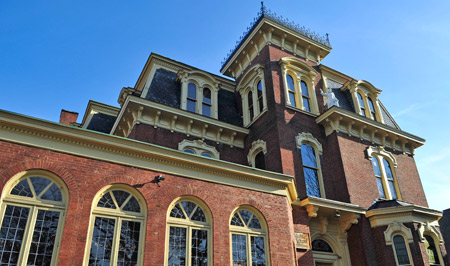
The Ursuline Academy (dates back to 1894), a Catholic girls school, opened in its Bloomfield location in 1894 and closed in 1981. In 1993, the building was sold, restored and named Victoria Hall, a venue for weddings and celebrations. The Waldorf School bought the property in 2003. Sidney Davis | Pittsburgh Tribune-Review
The ornate wood and plaster work inside the former Ursuline Academy in Bloomfield has been around for about 140 years.
A nomination to the National Register of Historic Places next month could ensure it lasts at least twice as long.
The building on South Winebiddle Street near the borders of Friendship Park, Garfield and Lawrenceville has been a hands-on laboratory for University of Pittsburgh students learning how to research historic buildings. The students will release their findings to the public at 7 p.m. Tuesday in the building’s auditorium.
The class plans to present the nomination to the Pennsylvania Historical and Museum Commission in January. If approved, the commission would send it to the National Park Service in Washington for a final review.
Officials with the building’s current tenant, the Waldorf School, a private school for students in kindergarten through fifth grade, applaud the efforts.
“It’s a wonderful place to have a school,” said Alexandra Gruskos, Waldorf’s board president and an attorney for the Allegheny County Office of Children, Youth and Families. “We’re very happy about the nomination.”
Students in Jeff Slack’s documentation and conservation studio course pored over historic maps, photographs, deeds and building permits in researching the history of the 21-room mansion built for Henry J. Lynch in the late 1860s.
“The nomination is the result of the ongoing work begun in 2008 by Pitt preservation students that included a detailed evaluation of the physical condition of the building,” Slack, a historic preservation planner at Pfaffmann + Associates, PC, Downtown, said in a written statement.
“But this year, the students’ work focuses more so on research that shows the far-reaching educational contributions of the Ursuline Academy to the local community.”
The historic designation would prevent federal money from being used to alter the building, said Brendan Froeschl, facilities manager for the Waldorf School. The building was well-preserved because it was turned into a school after initially being a residence, he said.
“The Ursulines did a wonderful job. When you come in the front door, you’re in the front door of the original mansion,” Froeschl said.
Dan Holland, director of the Young Preservationists Association of Pittsburgh, said other buildings across the city would benefit from the expertise of the class.
“To do this kind of work is a huge help,” Holland said.
The Ursuline Academy, a Catholic girls school, opened in its Bloomfield location in 1894 and closed in 1981. In 1993, the building was sold, restored and named Victoria Hall, a venue for weddings and celebrations. The Waldorf School bought the property in 2003.
-
Hotel Saxonburg Chef Returns to Recently Renovated Landmark
By Pam Starr, FOR THE PITTSBURGH TRIBUNE-REVIEW
Sunday, December 12, 2010
Hotel Saxonburg's executive chef, Alan Green, and owner, Judy Ferree, with Penne Carbonara Erica Hilliard | Valley News Dispatch
Judy Ferree loved Hotel Saxonburg so much as a customer that she decided to buy the Butler County landmark in July.
The former owner, Domenic Gentile, had died a few years ago, and his wife realized she couldn’t keep the restaurant going, says Ferree, a resident of Middlesex.
“I thought this would be a good project,” says Ferree, 50, who used to own Lakevue Athletic Club with her husband, Bob, and managed Butler Country Club for a number of years. “I had watched it slide, partly due to the economy, but I wanted to get Hotel Saxonburg back to where it was.”
Ferree closed the place for five weeks for needed renovation. All of the kitchen equipment was replaced, including the refrigeration units and ventilation system, and the entire interior was painted. The original tin ceiling in the dining room was repaired and painted.
But Ferree was careful to keep the old-fashioned charm and elegance that Hotel Saxonburg is known for. Hotel Saxonburg was built in 1832 and is listed in the National Registry of Historic Places. The black-and-white checkered floor tile is still intact, and the copper-topped bar dates to the 19th century. Five upstairs sleeping rooms have been meticulously refurbished to reflect the 1800s. Ferree points out that Woodrow Wilson once stayed there.
The 138-seat Hotel Saxonburg is the oldest continually operating restaurant and bar in Butler County, she says.
“We reopened on Aug. 12, and it’s been exciting,” she says. “It’s livened up the whole community. I brought back the chef, Alan Green, who was here for 18 years and left to work at the Springfield Grill for four years. He’s the heart of the place and is so approachable and humble. He’ll be the first one to jump in and help the dishwasher.”
Green, 55, has been cooking professionally for 35 years and hand-picked the culinary team when he returned. The Aliquippa native began his career while a student at Penn State, where he graduated with a Spanish degree.
“I cooked my way through school, and my knowledge of Spanish was invaluable while working as a chef in Washington, D.C.,” he says. “When I hire someone, the first thing I look for is enthusiasm, and the ability to look me in the eye. They also need to be able to take criticism.”
Green is very pleased with the chefs and cooks who work with him at Hotel Saxonburg.
“I have some young guns here that are terrifically talented but need steady guidance,” says Green, who is married and lives in Butler. “I can’t marathon anymore at my age, so I teach. I also try to learn something every day.”
The American menu is Green’s creation. He wanted to return to the classics, he says, as well as keep up with trends. His appetizers include staples such as crab cakes, fried asparagus and shrimp cocktail. But one will also find zucchini cakes with roasted red pepper sauce; ground beef sliders; Crimini mushrooms filled with clam stuffing and topped with bacon; and grilled New Zealand lamb chops.
Hotel Saxonburg is famous for its lobster bisque, and Green wouldn’t dream of taking that off the menu. Entrees feature classics such as filet mignon, baby back ribs, chicken gorgonzola and seafood pasta. Green includes other items like sauteed black sea bass filets; satay fire-grilled chicken skewers with wild mushrooms and marinara sauce; shrimp tempura with sweet Thai chile sauce; and cucumber-crusted salmon filet with a cucumber-wasabi puree.
Everything on the menu is made from scratch, he says.
“We get our seafood from Curtze Foods in Erie, and some from Pittsburgh Seafood,” Green says. “Our chicken, lamb and beef comes from Curtze, and US Foods. Our specialty products are from Thoma’s, right down the road, and their pork is superior. Perriello Produce in Natrona Heights handles our produce. They’re all good guys.”
The hours are the hardest part of being a chef, he says, but the “happy stuff far outweighs the dark stuff.” Writing cookbooks is on Green’s bucket list, and the first one will be about soups.
“All I do is think about food,” he says with a laugh. “I read food, I study food, I watch food. Cooking is very rewarding. When you get one customer who tells you how nice their dinner was, it makes your month.”
Penne Carbonara

Chef Alan Green is sharing is popular Penne Carbonara recipe. He uses local bacon from Thoma's to give the dish more oomph, and uses an egg in the final phase to thicken the dish. Erica Hilliard | Valley News Dispatch
Chef Alan Green is sharing is popular penne carbonara recipe. He uses local bacon from Thoma’s to give the dish more oomph, and uses an egg in the final phase to thicken the dish.
“The egg is a delicious way to enhance and enrich the flavor,” says Green. “The sauce should be just thick enough to coat the noodles. This is a good, wintery pasta dish that fills you up.”
He suggests serving this hearty meal with whatever wine you enjoy.
- 3 tablespoons clarified butter
- 2 tablespoons red onion, julienned
- 1 teaspoon minced garlic
- 1/4 cup thick-sliced bacon, diced
- Salt and freshly ground black pepper, to taste
- 1/2 cup heavy cream
- 12 ounces cooked penne pasta
- 1/4 cup grated Romano cheese
- 1 large egg
- 2 tablespoons chopped parsley
Put the butter, red onion, garlic and bacon in a saute pan over medium-high heat. Sweat the onion and garlic for about 2 minutes, and season with salt and pepper.
Add the heavy cream and bring to a boil. Reduce the heat and simmer until reduced by half.
Cook the pasta according to package directions, and drain well. Add the cooked pasta to the cream mixture and season again with salt and pepper. Add the Romano cheese, and then remove from the heat. Stir in the egg and mix well.
Place the pasta in a serving bowl, sprinkle with chopped parsley, and serve immediately.
Makes 2 servings.
Hotel Saxonburg:Cuisine: American
Hours: 11 a.m.-10 p.m. Tuesdays-Thursdays, 11 a.m.-11 p.m. Fridays and Saturdays, 11 a.m.-9 p.m. Sundays
Entree price range: $10-$23
Notes: Major credit cards accepted. Handicapped accessible. Reservations recommended for weekends. Bottles of wine for $15 featured on Tuesdays and Thursdays. Sunday brunch. Five hotel rooms upstairs.
Address: 220 Main St., Saxonburg, Butler County
Details: 724-352-4200 or website
-
Public Gets Hands-On With Ideas for South Park Fairgrounds
Thursday, December 09, 2010By Margaret SmyklaThe public put its money where its mouth was during a public meeting last week about the future of the South Park Fairgrounds.
Everyone in the audience was given $500 in fake money to play a kind of board game, placing the “money” on an element that the player thought was a priority.
Elements receiving heavy play included removing Schoonmaker Hall, improving the oval fields/track surfaces and enhancing the park gateways.
A popular write-in item was “improving bathrooms.”
The input from this meeting, as well as another public meeting in September and focus groups and an online survey will be incorporated into a report from GAI Consultants, of Homestead, that is planned for completion at month’s end.
The study is supported by the Richard King Mellon Foundation, the Heinz Endowments and the county.
While there is no money in hand for improvements, the county is more likely to receive funding from foundations, and the state and federal governments, if a plan is in place, said county parks director Andy Baechle. There is no timetable.
The process was set in motion through a master plan created several years ago for all nine county parks. One of its recommendations was the formation of a nonprofit parks foundation to which tax-deductible donations could be made.
That done, the master plan was again addressed, such as its call for a detailed vision of the 76 county-owned acres from Corrigan Drive to McCorkle Road encompassing the Fairgrounds, exhibit hall buildings, amphitheater, police barracks, Nature Center, tennis/basketball courts, and more.
“This area has a tons of potential, but it has lagged,” said Jeaneen Zappa, the Allegheny County’s sustainability manager.
At the meeting, three options — titled “Modified,” “Campus” and “Picturesque” — were presented to solicit comments from the audience.
The “Modified” option is based on what can be done fairly easily and economically, such as removing/repairing bleachers, improving oval fields/track surfaces and enhancing park gateways.
With “Campus,” which emphasizes pedestrians, the recommendations include removing Agricultural Hall for additional parking, adding a “green” parking lot at McCorkle and Brownsville roads and reclaiming the southern end of Catfish Run.
“Picturesque” focuses on the naturalistic quality of the park’s original planning, such as reconfiguring the oval track to curvilinear shape, relocating the tennis/basketball courts and relocating the nature center adjacent to Catfish Run.
Ms. Zappa said the final report will likely include elements of all three,
Christine Fuller, executive director of the Allegheny County Parks Foundation, said the organization will review the final report and work with the county on the next steps.
After the meeting, Jeff Danchik, director of the Mon Valley Express, a drum and bugle corps which leases space from the county at Brownsville Road and Corrigan Drive, said the area needs more attractions, such as a craft shows or flea markets.
“A lot of people don’t know we’re here,” Mr. Danchik said.
Walt Sackinsky of South Park said he would like to see the infrastructure addressed, such as aging water, gas, and sewer lines, and fire hydrants.
For Terry Tressler of South Park, priorities include improvements to Corrigan Drive such as adding a middle turning lane with room on each side of the road for walkers and bikers.
His wife, Donna Tressler, would like to see Schoonmaker Hall, which is used for storage, razed. “It is falling down and dangerous, with kids going in and out,” she said.
A big priority for both is improving the bathrooms.
The couple, lifetime park users, are hopeful for change after attending both public meetings.
“I’m impressed with the caliber of people who seem to want to improve the park,” he said.



